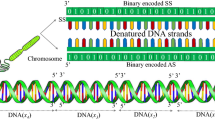Abstract
Maximum parsimony and maximum likelihood approaches to phylogenetic reconstruction were proposed with the aim of describing the evolutionary history of species by using different optimality principles. These discrepant points of view can lead to situations where discordant topologies are inferred from a same dataset. In recent years, research efforts in Phylogenetics try to apply multiobjective optimization techniques to generate phylogenetic topologies which suppose a consensus among different criteria. In order to generate high quality topologies, it is necessary to perform an exhaustive study about topological search strategies as well as to decide the most fitting molecular evolutionary model in agreement with statistical measurements. In this paper we report a study on different operators and models to improve a Multiobjective Artificial Bee Colony algorithm for inferring phylogenies according to the parsimony and likelihood criteria. Experimental results have been evaluated using the hypervolume metrics and compared with other multiobjective proposals and state-of-the-art phylogenetic software.
Access this chapter
Tax calculation will be finalised at checkout
Purchases are for personal use only
Preview
Unable to display preview. Download preview PDF.
Similar content being viewed by others
References
Swofford, D., Olsen, G., Waddell, P., Hillis, D.: Phylogenetic Inference. Molecular Systematics 2, 407–514 (1996)
Felsenstein, J.: Inferring phylogenies. Sinauer Associates, Sunderland (2004) ISBN: 0-87893-177-5
Matsuda, H.: Construction of phylogenetic trees from amino acid sequences using a genetic algorithm. In: Proceedings of Genome Informatics Workshop, pp. 19–28. Universal Academy Press (1995)
Lewis, P.O.: A Genetic Algorithm for Maximum-Likelihood Phylogeny Inference Using Nucleotide Sequence Data. Molecular Biology and Evolution 15(3), 277–283 (1998)
Congdon, C.: GAPHYL: An evolutionary algorithms approach for the study of natural evolution. In: Genetic and Evolutionary Computation Conference, pp. 1057–1064 (2002)
Cotta, C., Moscato, P.: Inferring Phylogenetic Trees Using Evolutionary Algorithms. In: Guervós, J.J.M., Adamidis, P.A., Beyer, H.-G., Fernández-Villacañas, J.-L., Schwefel, H.-P. (eds.) PPSN VII. LNCS, vol. 2439, pp. 720–729. Springer, Heidelberg (2002)
Bos, D.H., Posada, D.: Using models of nucleotide evolution to build phylogenetic trees. Developmental and Comparative Immunology 29, 211–227 (2005)
Rokas, A., Williams, B.L., King, N., Carroll, S.B.: Genome-scale approaches to resolving incongruence in molecular phylogenies. Nature 425(6960), 798–804 (2003)
Deb, K.: Multi-objective Optimization Using Evolutionary Algorithms. Wiley-Interscience Series in Systems and Optimization. John Wiley & Sons, Chichester (2001) ISBN: 978-0-471-87339-6
Poladian, L., Jermiin, L.: Multi-Objective Evolutionary Algorithms and Phylogenetic Inference with Multiple Data Sets. Soft Computing 10(4), 359–368 (2006)
Coelho, G.P., da Silva, A.E.A., Von Zuben, F.J.: Evolving Phylogenetic Trees: A Multiobjective Approach. In: Sagot, M.-F., Walter, M.E.M.T. (eds.) BSB 2007. LNCS (LNBI), vol. 4643, pp. 113–125. Springer, Heidelberg (2007)
Cancino, W., Delbem, A.C.B.: A Multi-Criterion Evolutionary Approach Applied to Phylogenetic Reconstruction. In: Korosec, P. (ed.) New Achievements in Evolutionary Computation, pp. 135–156. InTech (2010) ISBN: 978-953-307-053-7
Karaboga, D.: An idea based on honey bee swarm for numerical optimization. Tech. Rep. TR06, Erciyes University, Engineering Faculty, Computer Engineering Department (2005)
Schmidt, O., Drake, H.L., Horn, M.A.: Hitherto Unknown [Fe-Fe]-Hydrogenase Gene Diversity in Anaerobes and Anoxic Enrichments from a Moderately Acidic Fen. Applied and Environmental Microbiology 76(6), 2027–2031 (2010)
Pol, D., Siddall, M.E.: Biases in Maximum Likelihood and Parsimony: A Simulation Approach to a 10-Taxon Case. Cladistics 17(3), 266–281 (2001)
Santander-Jiménez, S., Vega-Rodríguez, M.A., Gómez-Pulido, J.A., Sánchez-Pérez, J.M.: Inferring Phylogenetic Trees Using a Multiobjective Artificial Bee Colony Algorithm. In: Giacobini, M., Vanneschi, L., Bush, W.S. (eds.) EvoBIO 2012. LNCS, vol. 7246, pp. 144–155. Springer, Heidelberg (2012)
Snell, Q., Whiting, M., Clement, M., McLaughlin, D.: Parallel Phylogenetic Inference. In: Proceedings of the 2000 ACM/IEEE conference on Supercomputing, Article 35. IEEE Computer Society (2000)
Goëffon, A., Richer, J.M., Hao, J.K.: Progressive Tree Neighborhood Applied to the Maximum Parsimony Problem. IEEE/ACM Transactions on Computational Biology and Bioinformatics 5, 136–145 (2008)
Karaboga, D., Gorkemli, B., Ozturk, C., Karaboga, N.: A comprehensive survey: Artificial Bee Colony (ABC) algorithm and applications. Artificial Intelligence Review, 1–37 (2012), doi:10.1007/s10462-012-9328-0
Dutheil, J., Gaillard, S., Bazin, E., Glémin, S., Ranwez, V., Galtier, N., Belkhir, K.: Bio++: a set of C++ libraries for sequence analysis, phylogenetics, molecular evolution and population genetics. BMC Bioinformatics 7, 188–193 (2006)
Guindon, S., Dufayard, J.F., Lefort, V., Anisimova, M., Hordijk, W., Gascuel, O.: New Algorithms and Methods to Estimate Maximum-Likelihood Phylogenies: Assessing the Performance of PhyML 3.0. Systematic Biology 59(3), 307–321 (2010)
Deb, K., Pratap, A., Agarwal, S., Meyarivan, T.: A fast and elitist multi-objective genetic algorithm: NSGA-II. IEEE Transactions on Evolutionary Computation 6, 182–197 (2002)
Goloboff, P.A., Farris, J.S., Nixon, K.C.: TNT, a free program for phylogenetic analysis. Cladistics 24, 774–786 (2008)
Stamatakis, A.: RAxML-VI-HPC: Maximum Likelihood-based Phylogenetic Analyses with Thousands of Taxa and Mixed Models. Bioinformatics 22(21), 2688–2690 (2006)
Author information
Authors and Affiliations
Editor information
Editors and Affiliations
Rights and permissions
Copyright information
© 2012 Springer-Verlag Berlin Heidelberg
About this paper
Cite this paper
Santander-Jiménez, S., Vega-Rodríguez, M.A., Gómez-Pulido, J.A., Sánchez-Pérez, J.M. (2012). Comparing Different Operators and Models to Improve a Multiobjective Artificial Bee Colony Algorithm for Inferring Phylogenies. In: Dediu, AH., Martín-Vide, C., Truthe, B. (eds) Theory and Practice of Natural Computing. TPNC 2012. Lecture Notes in Computer Science, vol 7505. Springer, Berlin, Heidelberg. https://doi.org/10.1007/978-3-642-33860-1_16
Download citation
DOI: https://doi.org/10.1007/978-3-642-33860-1_16
Publisher Name: Springer, Berlin, Heidelberg
Print ISBN: 978-3-642-33859-5
Online ISBN: 978-3-642-33860-1
eBook Packages: Computer ScienceComputer Science (R0)




